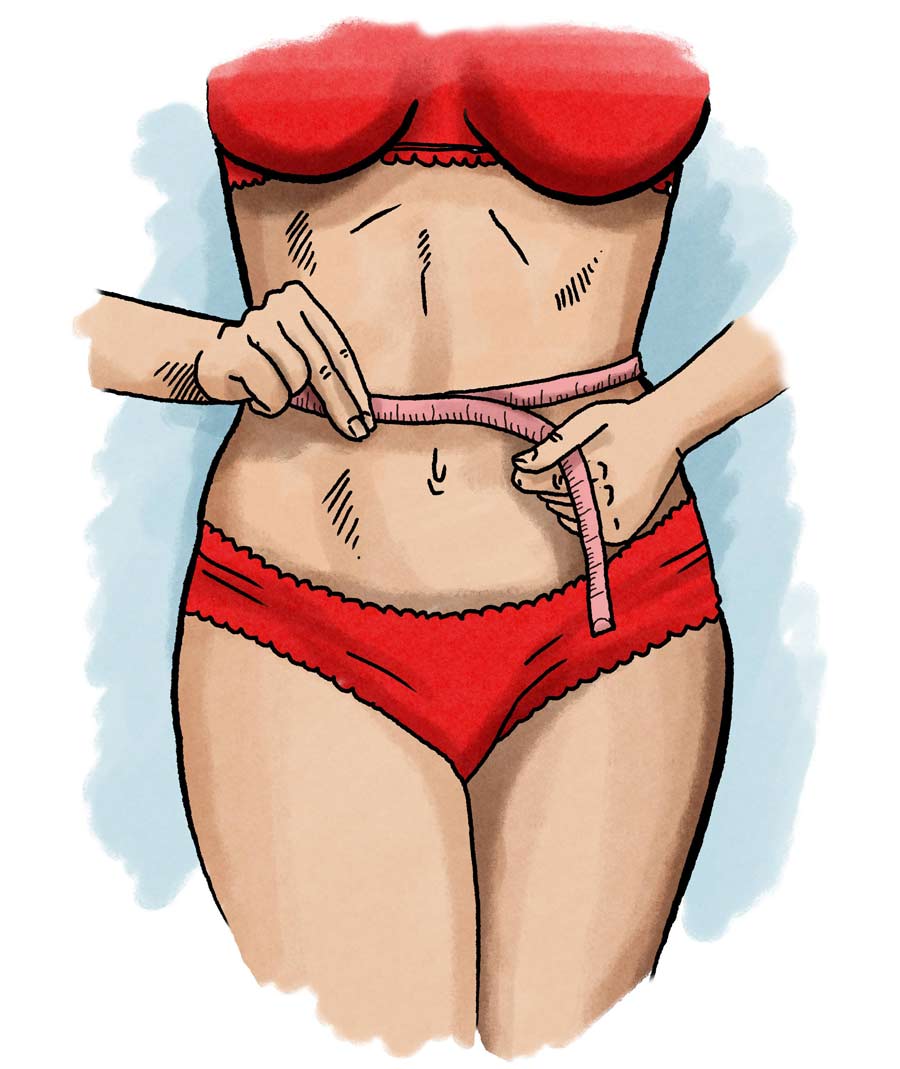To calculate BMI, measure weight in kilograms and height in meters squared (this is your height in meters times itself). Then, take these numbers and divide weight by square height. Using an online calculator tool is an easy way to determine BMI.
How To Measure Your Waist Correctly
If you’ve been paying attention to our latest podcasts, articles, Q/A’s, and other content then you’ve likely heard us discuss the importance of waist circumference in determining who is a good candidate for weight gain and who could stand to lose a bit of weight.
Waist circumference is a quick, low-cost piece of data with reams of scientific evidence relating the distance around your abdomen with health outcomes like premature death, diabetes, heart disease, stroke risk, etc. While the aforementioned disease processes have many variables contributing to their development and burden, we have large, well-designed studies showing that males and females that have a waist circumferences greater than 40 or 34 inches, respectively, have much higher risks of disease than those who do not.*
That said, there’s a right and a wrong way to do this and we want to make sure you’re doing it correctly. The venerable belly button-or more properly, the umbilicus- is typically the anatomical location suggested to take the waist circumference measurement, but this not actually where much of the waist circumference data described above comes from.
To further complicate things, some large data sets do not even report the procedure used to obtain the waist measurements being studied.
On the plus side, we have some guidance from the Centers for Disease Control and Prevention (CDC) who commission yearly data collection series, The National Heallth and Nutrition Examination Survey (NHANES). Given that many of the waist circumference studies rely on NHANES data, it is reasonable to use their procedure for our own purposes as well. Here’s the rundown:
- Use your hand to feel the bony prominences on the front of your hip and find the highest one, theanterior superior iliac spine (ASIS).
- Draw a horizontal line to mark ASIS with cosmetic pencil on both sides
- Place tape measure around waist with the base of the tape measure flush the marked line.
- Pull the tape snug, but do not compress the skin such that it’s indented by the tape measure
- Measure to the nearest 0.1cm at the end of expiration.

Practically speaking, I’m aware that most folks are not going to use a cosmetic pencil to measure their waists so I would recommend feeling for the ASIS and then placing the tape around the area just above that bony projection- taking care to keep the tape level to the floor.
So, what does this measurement mean? If it is greater than 40 or 34″ for a male or female, respectively, then I would recommend immediate weight loss via calorie restriction and training modifications (if needed). Additionally, if someone is within an inch or so of the cut-point, I’ll typically recommend either maintenance level calories if they are relatively untrained, as the waist circumference tends to decrease readily in this population with training. If the person is more advanced and has been gaining weight, I’ll usually reverse the process at this point unless additional contextual factors are present, e.g. a meet very soon.
And there you have it folks, how to measure your waist, what it means, and what to do about it. Thanks for reading!
-Jordan Feigenbaum, MD
*At present, there appears to be some ethnic differences in waist circumference “cut-points”, e.g. men and women of Asian descent appear to have cut points of 37 and 34 inches, respectively. Additionally, some national guidelines suggest that lower cut points of 37″ and 31″ for men and women, respectively, should be used to identify those at increased risk of adiposity-related chronic disease. That said, we follow the current American Academy of Clinical Endocrinology’s Obesity Guidelines of 40 and 34 inch cut points referred to in this section for all non-Asian men and women as a screening tool.
How to measure your waist: Health and waistline size
A person’s waistline measurement reveals more information than just their clothing size. It can also indicate an individual’s current or future health prospects.
A larger waistline may be due to having excess weight around the abdomen. This, in turn, increases the risk of certain health conditions.
In this article, we explain how to measure the waistline and the link between waist size and health. We also look at the factors that influence waist size and tips for reducing a larger waist.

By following simple instructions, taking a waistline measurement with a tape measure is easy.
- Remove or wear thin clothing around the abdomen and hips.
- Hold the tape measure between the top of the hipbone and the bottom of the ribs.
- Breathe out normally.
- Bring the tape around the waist.
- Do not hold the tape too tight and ensure the tape measure is straight around the back.
- Record the measurement.
According to the Heart Foundation, a healthy waistline size is:
- 37 inches or less for men
- 31.5 inches or less for women
A person’s health may be at risk if their waist circumference is bigger.
While the waistline is a key measure of a person’s overall health risk, a person should also consider their waist-to-height ratio (WHtR) and body mass index (BMI).
Waist-to-height ratio
A person’s WHtR measures the distribution of body fat.
A 2018 observational study indicated that waist circumference and WHtR could be good indicators of high blood pressure (hypertension) risk.
Another study in 2016 concluded that WHtR is more effective than BMI and waist circumference at identifying those at ‘early health risk’ of central obesity-related illnesses when using a boundary value of WHtR of 0.5, or 50%.
A person is at higher risk of developing central obesity-related illness if they have a WHtR of over 50%.
To calculate WHtR, measure the waist circumference and height in inches. Then, divide the waist circumference by height, and multiply by 100.
Individuals who have either overweight or obesity are at higher risk of developing conditions such as heart disease and type 2 diabetes. People of moderate weight are also at greater risk of developing these conditions if they have an increased waist circumference, according to the National Heart, Lung and Blood Institute NHLBI) .
BMI is another useful measurement when it comes to bodyweight and health.
To calculate BMI, measure weight in kilograms and height in meters squared (this is your height in meters times itself). Then, take these numbers and divide weight by square height. Using an online calculator tool is an easy way to determine BMI.
The NHLBI indicate that BMI ranges for most adults aged 18–65 are as follows:
- under 18.5 — underweight
- 18.5–24.9 — healthy
- 25–29.9 — overweight
- 30 or more — obese
BMI does not distinguish between weight carried as fat or muscle or the distribution of fat on the body. It may not, therefore, provide an accurate assessment of a person’s health in some instances.
For example, athletes may have a high BMI but may not be at higher risk of certain health conditions. Older adults may have a lower BMI due to low muscle mass, yet they may be at higher risk of heart disease and other illnesses.
Having a larger waistline indicates that a person has excess abdominal fat. Abdominal fat of the visceral fat type is different from fat that accumulates on the thighs, as visceral fat is located inside your abdominal cavity.
When fat cells in visceral fat break down, they release free fatty acids and other substances into the portal vein. The portal vein brings blood from the intestines to the liver.
These substances cause a state of toxicity that affects the pancreas and reduces its ability to produce the hormone insulin. Insulin is needed for cells to be able to take up glucose in the body.
This toxicity also contributes to insulin resistance, where the body’s cells do not respond properly to insulin. Both of these factors mean that the body’s blood sugar levels increase.
Excessive visceral fat increases inflammation in the body.
How To Measure Your Waist
Whether you’re ordering clothes online, monitoring your weight, or designing a bespoke bucket chair for your space-shuttle to the moon (look, the world is on fire; it’s OK to have a plan B), you need to be able to measure your body accurately. Here’s how to get the digits for your waist.
Waist circumference measurements
Waist measurements are a bit of a life-saver when it comes to shopping for clothes. Dress sizes differ massively between the US, EU and the UK, and vague descriptors on men’s clothing aren’t much help either (S, M, L. More like FML). Checking the centimetres or inches is the most reliable thing to do to make sure your clothes fit well. If you find yourself needing to convert between cm and inches, by the way, we’ve got your back with our cm to inches converter.
In the world of healthcare, an accurate waist measurement can be used as an indicator of visceral fat, a type of body fat that’s stored within the abdominal cavity and located around vital organs such as the liver and stomach. Visceral fat has been linked to an increased risk of health complications such as heart disease, cancer and type 2 diabetes. In addition, a waist measurement can also be used as the first step towards working out your WHR (waist-to-hip ratio), another indicator of health risks. You can learn more about WHR here, and we have also included a link to the WHR calculator for you at the bottom of this article.
Before you start measuring
Find yourself a fabric tape measure (not a metal DIY one! :D) or a piece of string which you can use to mark and measure. It’s also a good idea to have a piece of paper and pen (or your smartphone) to hand, so that you can jot down the measurement (you don’t want to go to all the effort of measuring your waist and then forget the measurement). Once you have those things ready, we can start measuring.
Here’s how to measure your waist
- Remove or lift your shirt.
- Find the halfway point between your bottom rib and the top of your hips, just above your belly button. This is where you’ll measure your waist.
- Slowly exhale (sucking in your tummy makes the whole exercise pointless).
- Wrap the tape around your waist and make sure it’s level on each side, not slipping down or pulled up high and not twisted. It should be parallel to the floor.
- Measure with the tape held snug around your skin: not too loose, but also not cutting into your skin. Take the measurement.
- Repeat the process, just to double-check the accuracy of your original measurement.
- Ta-da! That’s your waist measurement.

Measuring waist circumference – video
If you’re still unsure whether you’re measuring your waist circumference correctly, here’s a great video from Dr. Lara.
Waist measurement completed, here’s some ideas to consider:
- Pat yourself on the back and buy your new jacket / dress / trousers.
- Measure your hips in order to calculate a Waist-to-Hip measurement.
- Interpret your waist measurement result.
Let’s take a look at number 3 together now.
Interpreting your waist measurement results
Ideally, you should look at a range of measurements before making an assessment of your personal health, and you’re recommended to consult a qualified health professional before considering radical changes to your lifestyle. With that in mind, several leading health organisations have published the following general information on waist sizes.
The World Cancer Research fund, World Health Organisation and NHS England state that your health may be at risk if your waist is*:
- Women: more than 80cm (31.5 inches)
- Men: more than 94cm (37 inches)
*Excludes those who are pregnant or have a medical condition causing a swollen abdomen. Information may vary for Asian populations. Always talk to a Doctor for medical advice.
In addition, the National Institutes of Health, U.S., states the following when assessing waist size and health risk:
If most of your fat is around your waist rather than at your hips, you’re at a higher risk for heart disease and type 2 diabetes. This risk goes up with a waist size that is greater than 35 inches for women or greater than 40 inches for men.
I do hope this article has proved useful to you. Should you wish to calculate your waist-to-hip ratio, check out our WHR calculator. Or, you can calculate your BMI here.
Written by Alastair Hazell
(with assistance from Becky Kleanthous)






